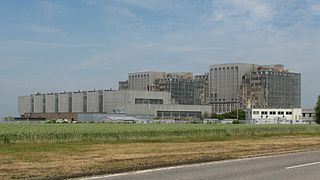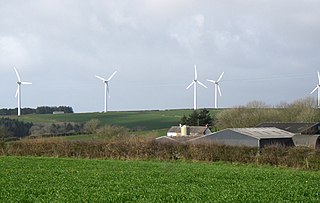Related Research Articles

Electricity generation is the process of generating electric power from sources of primary energy. For utilities in the electric power industry, it is the stage prior to its delivery to end users or its storage.
The Central Electricity Generating Board (CEGB) was responsible for electricity generation, transmission and bulk sales in England and Wales from 1958 until privatisation of the electricity industry in the 1990s.

Bankside Power Station is a decommissioned electricity generating station located on the south bank of the River Thames, in the Bankside area of the Borough of Southwark, London. It generated electricity from 1891 to 1981. It was also used as a training base for electrical and mechanical student apprenticeships from all over the country. Since 2000 the building has been used to house the Tate Modern art museum and gallery.
The British Electricity Authority (BEA) was established as the central British electricity authority in 1948 under the nationalisation of Great Britain's electricity supply industry enacted by the Electricity Act 1947. The BEA was responsible for the generation, transmission and sale of electricity to area electricity boards, and the development and maintenance of an efficient, coordinated and economical system of electricity supply.

Hartlepool nuclear power station is a nuclear power station situated on the northern bank of the mouth of the River Tees, 2.5 mi south of Hartlepool in County Durham, North East England. The station has a net electrical output of 1,190 megawatts, which is 2% of Great Britain's peak electricity demand of 60 GW. Electricity is produced through the use of two advanced gas-cooled reactors (AGR). Hartlepool was only the third nuclear power station in the United Kingdom to use AGR technology. It was also the first nuclear power station to be built close to a major urban area.
This timeline outlines the key developments in the United Kingdom electricity industry from the start of electricity supplies in the 1870s to the present day. It identifies significant developments in technology for the generation, transmission and use of electricity; outlines developments in the structure of the industry including key organisations and facilities; and records the legislation and regulations that have governed the UK electricity industry.
Nuclear power in the United Kingdom generated 16.1% of the country's electricity in 2020. As of March 2022, the UK has 11 operational nuclear reactors at five locations, producing 6.8 GWe. It also has nuclear reprocessing plants at Sellafield and the Tails Management Facility (TMF) operated by Urenco in Capenhurst.
The South of Scotland Electricity Board (SSEB) generated, transmitted and distributed electricity throughout the south of Scotland, including the former regions of Strathclyde, Lothian, Fife, Central, Borders and Dumfries and Galloway and a few towns in northern England. It operated from 1955 to 1991.

Total energy consumption in the United Kingdom was 142.0 million tonnes of oil equivalent in 2019. In 2014, the UK had an energy consumption per capita of 2.78 tonnes of oil equivalent compared to a world average of 1.92 tonnes of oil equivalent. Demand for electricity in 2014 was 34.42 GW on average coming from a total electricity generation of 335.0 TWh.

Bradwell nuclear power station is a decommissioned Magnox-design nuclear power station located on the Dengie peninsula at the mouth of the River Blackwater, Essex. In 2019, it was the first nuclear power station in the UK to be placed into long-term decommissioned management. As of 2016, China General Nuclear Power Group and China National Nuclear Corporation are considering Bradwell for the site of a new nuclear power station.

The Sizewell nuclear site consists of two nuclear power stations, one of which is still operational, located near the small fishing village of Sizewell in Suffolk, England. Sizewell A, with two Magnox reactors, is now in the process of being decommissioned. Sizewell B has a single pressurised water reactor (PWR) and is the UK's newest nuclear power station. A third power station, to consist of twin EPR reactors, is planned to be built as Sizewell C.

Renewable energy in the United Kingdom can be divided into production for electricity, heat, and transport.

Roosecote Power Station was a gas-fired, originally coal-fired power station, situated in the Roosecote district of Barrow-in-Furness in Cumbria, North West England. The gas-fired station opened in 1991 and was the first CCGT power station to supply electricity to the United Kingdom's National Grid, but was mothballed in 2012 after a proposed biomass power station was cancelled. It was situated directly adjacent to Rampside Gas Terminal. The plant was demolished between 2014 and 2015. The site is now a 49 MW battery storage facility.

The United Kingdom has a National Grid that covers most of mainland Great Britain and several of the surrounding islands, as well as some connectivity to other countries. The electrical sector supplies power at 50 Hz AC, and ~240 volts is supplied to consumers. In 2020 the electricity sector's grid supply came from 55% low-carbon power, 36.1% fossil fuelled power, and 8.4% imports. Renewable power is showing strong growth, while fossil fuel generator use in general and coal use in particular is shrinking, with historically dominant coal generators now mainly being run in winter due to pollution and costs, and contributed just 1.6% of the supply in 2020.

Sir William Leonard Owen was a British civil engineer and nuclear engineer. As Director of Engineering at the British Atomic Energy Project, he oversaw the construction of the Springfields Chemical and Fuel Element Plants, the Windscale Piles, Windscale plutonium extraction plant, Capenhurst gaseous diffusion plant and the Calder Hall nuclear power station.

Huncoat Power Station was located in Huncoat near Accrington, Lancashire. It was a 150 MW, coal-fired, electricity generating station in operation from 1952 to 1984. It has since been demolished. Huncoat power station replaced the earlier Accrington power station that had supplied electricity to the town since 1900.
The Lancaster power stations provided electricity to the Lancashire town and city of Lancaster and the surrounding area from 1894 to 1976. The first power station was built and operated by Lancaster Corporation and started generating electricity in April 1894. The second power station was built during the First World War near the Lune Aqueduct to provide electric power for a munitions factory. When the factory closed after the war the power station was purchased by the corporation to provide electric power throughout its supply area.
Maentwrog power station was built by the North Wales Power Company and supplied electricity to North Wales, Deeside and Cheshire. It exploits the water resources of the Snowdonia mountains, using water turbines to drive electricity alternators. The 24 MW station has been owned by several organisations; since 2004 it has been owned by the Nuclear Decommissioning Authority. In generates an annual electricity output of 60.6 GWh.
Burnley power station supplied electricity to the town of Burnley, Lancashire from 1893 to the 1958. The electricity station was owned and operated by Burnley Corporation prior to the nationalisation of the British electricity industry in 1948. It was redeveloped as demand for electricity grew and old plant was replaced, and had an ultimate generating capacity of 8 MW in the 1920s. The station closed in 1958.
Nelson power station supplied electricity to the town of Nelson, Lancashire and the surrounding area from 1892 to 1960. The power station was owned and operated by Nelson Corporation prior to the nationalisation of the British electricity supply industry in 1948. It was redeveloped in 1922 to 1925 to meet the increased demand for electricity.
References
- ↑ The Navy List (Volume II ed.). Royal Navy. July 1945. p. 1619.
- ↑ Young, Bill. "Something in the environment : a conflict of value". Open University Digital Archive. Open University. Retrieved 6 April 2018.
- ↑ Nuclear Energy. British Nuclear Energy Society. 1979. p. 398. Retrieved 6 April 2018.
- ↑ Nuclear Engineering (Volume 8 ed.). Temple Press. 1963. p. 155. Retrieved 11 April 2018.
- ↑ McInerney, Tom. "An Oral History of the Electricity Supply in the UK". Sounds.bl.uk. Retrieved 6 April 2018.
- ↑ "Order of the British Empire". The London Gazette. 49008: 11. 12 June 1982. Retrieved 6 April 2018.
- ↑ Pask, Mrs D. "Commander Douglas A. Pask (Electrical and Electronic Engineering 1941)". Imperial College London.
- ↑ "One-Name Study of Surnames". Pask.org.uk. Retrieved 11 April 2018.
- ↑ Ledger, Frank (8 September 2017). Crisis Management in the Power Industry: An Inside Story. Routledge. ISBN 978-1351394291 . Retrieved 6 April 2018.